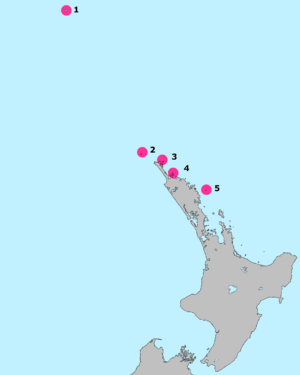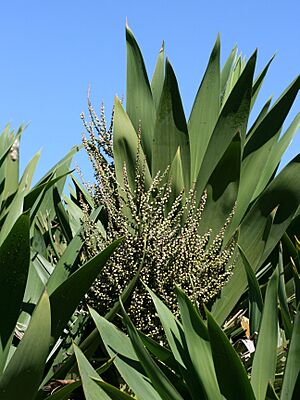Ti''' facts for kids
Quick facts for kids Ti''' |
|
|---|---|
 |
|
| Scientific classification | |
| Genus: |
Cordyline
|
| Species: |
obtecta
|
 |
|
| Natural range of C. obtecta (red) | |
| Synonyms | |
|
Cordyline baueri Hook.f. nom. illeg |
|
The Cordyline obtecta is a special kind of tree, also known as the Ti, Norfolk Island cabbage tree, or Three Kings cabbage tree. It's a type of plant called a monocot that grows with many branches. You can find it naturally on Norfolk Island and in the northern parts of New Zealand. The name obtecta comes from a Latin word meaning 'to cover up'. This name was given because the plant's flowers were almost hidden by its leaves when it was first discovered.
Contents
Where the Cabbage Tree Grows
On Norfolk Island, the Cordyline obtecta grows in forests. You can see it on mountains like Mt Bates and Mt Pitt, and in the National Park.
In New Zealand, this tree was first called C. kaspar. People thought it only grew on the Three Kings Islands. These islands are about 55 kilometers north of the North Island. Later, it was also found on the North Island at North Cape. It was also seen on Murimotu Island and the Poor Knights Islands. In 2005, scientists realized that C. kaspar was the same plant as C. obtecta.
What the Cabbage Tree Looks Like
The Cordyline obtecta is a cabbage tree that can grow up to 10 meters tall. However, it is usually much shorter. Its main trunk is thick, about 20 to 30 centimeters wide.
The tree has branches that spread out. These branches are covered with many stiff leaves. The leaves grow in bunches at the ends of the branches. Each leaf is about 35 to 100 centimeters long. They are 2.5 to 7 centimeters wide. The leaves become narrower near their base. They have short stems about 2.5 to 3.5 centimeters wide. As the leaves get older, they tend to droop a little.
The flowers of C. obtecta grow in large, open bunches. These bunches are called panicles and appear among the leaves. Each flower is tiny, about 1 millimeter across. They have a very strong scent. The fruit of the tree is a round berry. It is 4 to 5 millimeters wide. The berries can be whitish or a purplish-blue color. The bark on the trunk is grey and often flakes off.
Threats to the Cabbage Tree
On Norfolk Island, many C. obtecta trees are in danger. This is especially true for those growing outside the national park. Because of this, it is listed as a 'vulnerable' plant. This listing is under Australia's Environment Protection and Biodiversity Conservation Act 1999.
In New Zealand, the plant is listed as 'At Risk/Range Restricted'. This means it is not found in many places. Sometimes, in New Zealand, C. obtecta can mix with another plant, C. australis. When they mix, they create new plants. These new plants have features that are a mix of both parent trees.
Growing the Cabbage Tree
The Cordyline obtecta is a beautiful small tree. It looks great in gardens. It can handle full sun, but it likes some shade when it is young. This tree does not like very wet places. It is also likely to be sensitive to frost, which means cold weather can harm it.
There are at least two types of C. obtecta that you can buy. They are becoming popular for planting along streets and in home gardens.
- Green Goddess is likely from the Three Kings Islands. It has leaves that are a bit dull and have a slightly blue-green color. Its fruit bunches stand up straight.
- Emerald Goddess probably comes from Norfolk Island. It has shiny, bright green leaves. Its fruit bunches hang down loosely.


